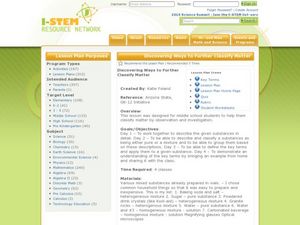Cornell University
Electroplating
Silver pennies and copper nickels are made possible by applying some chemistry. Learners use electrolysis to coat a penny with zinc sulfate and a nickel with copper sulfate. Their investigation builds an understanding of electroplating...
Curated OER
Determination of Phosphorus Content in River Water
Divide your chemistry or environmental science class into two groups. Each group tests water samples from a river for the concentration of phosphorus using a different method. With chemists, you can use this activity as they learn to use...
Curated OER
Investigating the Effect of Salinity on the Density and Stability of Water
Water with varying amounts of dissolved salt are dyed and then used to compare densities. The objective is to discover the effect of salinity, and therefore density, on ocean water on the stability of the ocean. Many branches of science...
Curated OER
Webquest: Eradicating Guinea Worm Disease in Ghana
Young scholars examine the impact of Guinea Worm Disease. In this world issues lesson, students take on the roles of Peace Corps Volunteers. Young scholars will apply their knowledge of the Guinea worm life cycle to create a plan for...
Curated OER
Apply Scientific Inquiry and Scientific Habits of Mind
Young scholars review the components of the scientific inquiry method. In groups, they develop hypothesis on a variety of different topics and design an investigation or experiment to test it. They share their conclusions with the class...
Mascil Project
Water Quality
How do you prevent the spread of water-borne illness in large public swimming areas? Scholars discover the challenges to identifying safe water through an inquiry experiment. They then produce posters sharing their understanding of water...
Curated OER
Maple Syrup
Students comprehend the process of making pure maple syrup. They identify differences between pure syrup and artifical maple syrup. Students are asked what is in the displayed containers. They sample the syrups and try to figure out...
Curated OER
Discover Ways to Further Classify Matter
Students analyze and classify substances. In this classifying matter lesson, students look at various substances and identify them as heterogeneous or homogeneous mixtures, pure substances, or solutions. Students bring something...
Curated OER
Visual Models of Solutions and Concentrations
Learners model solutions with beakers of colored glass or plastic spheres. In this solutions lesson, students use beakers of colored spheres to represent pure substances. They mix the spheres to demosntrate solutions. They discuss...
Curated OER
Isolating Bacteria from a Mix Culture
Students isolate three species of bacteria using the plate streak method, implement sterile microbiology techniques, and produce pure cultures of each microorganism at the end of this exercise. They write a descriptive paragraph for each...
National Nanotechnology Infrastructure Network
Creating and Testing Silver-Nanoparticle Socks
Antibacterial socks are a product of nanotechnology. An inquiry-based instructional activity asks collaborative groups to create their own antibacterial socks and then test them against other products on the market. The sock with the...
Curated OER
Maxima and Minima Problems
Students calculate the maxima and minima of quadratic equations. In this calculus lesson plan, students apply the derivatives by finding the maxima and minima using real life application. They solve optimization using the derivative.
Curated OER
Exploring the Scientific Method: Separation of a Complex Mixture
Students work in teams to use the scientific method to separate complex mixtures into pure components.
Curated OER
Microbiology Lesson Plan Aseptic Technique
Students examine the importance of aseptic technique, become familiar with media plates, and general microbiology techniques. They study the benefits and dangers of bacteria and other microorganisms in their lives.
Curated OER
Separation of a Complex Mixture
Learners develop a method to separate different types of mixtures. In this chemistry lesson, students model the steps in the scientific method. They perform the experiment and analyze data.
Curated OER
Water Quality Tests Explained
Learners identify the eight tests done to check for water quality. In this ecology activity, students explain why it's important to test water in rivers. They explore sources of river water pollution.
Curated OER
The Discovery of Ohm's Law
Learners study Georg Ohm and how he changed mathematics with his law. In this experimental evidence and stastics instructional activity students complete an experiment on the characteristics of Ohm's law.
Curated OER
Water Quality Tests Explained
Students define all eight water quality parameters and list at list one source for each of the eight water quality parameters. They determine how each of the eight parameters affect river ecosystems.
Curated OER
Water Density and Stability Lab
Students observe how different water densities and salinity control the depth at which different water masses occur. Submarines are used as a case study. This is a well-designed with an excellent worksheet.
Curated OER
Making Cents of Density
Middle schoolers utilize their knowledge of the physical properties of matter such as mass, volume, and density to solve a problem. They utilize the scientific method to solve a problem. Pupils analyze their data to determine whether...





















